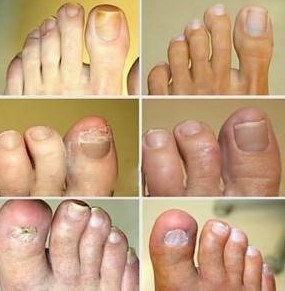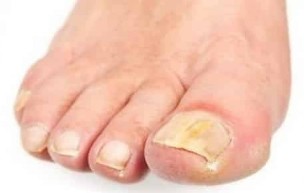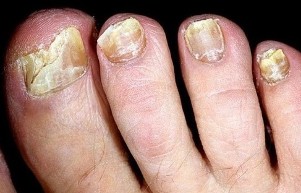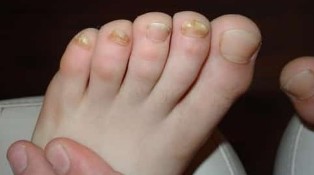Onychomycosis – a disease that destroys the nail plate. Fungus are keratin – building the Foundation of the nail. The infection gets into the extracellular space and begins its division. In advanced stages of the pathology can affect the skin of the feet, toe area, heel.

The causes of toe nail fungus
You can get infected with onychomycosis is quite easy. The infection can lurk on the beach, public shower, or swimming pool. A high probability of catching a fungus of ad-infected relatives or friends (using the common tools of everyday life).
There are several main reasons that can trigger the virus spread in the human body:
- weak immune system – reduction of protective forces as a result of diseases of infectious or inflammatory origin.
- pathology of blood vessels (vein occlusion) violations of the internal organs (diabetes) that lead to the problems with blood circulation in the lower extremities;
- minor damage to the skin on the feet (scratches, cracks, corns, calluses), which emerged as the result of wearing tight shoes;
- ignoring the rash and intense sweating of the lower extremities;
- violation of precautionary measures – trying on someone else's shoes, visiting public places without Slippers, and neglect of hygiene of the feet.
Types of nail fungus
Onychomycosis can provoke several types of fungi. Dermatophytes, for example, manifested in the form of opacities of the nail. Observed the formation of yellow spots on the sides or in the middle of the plate. In addition, there may be a longitudinal strip along the affected area.
Yeast fungus provokes a deformation of the nail plate. It greatly thins and begins to leave hell in his seat, turning gray. Metabolism of injured cells worsens, the nail shaft phenomenon furrows appear. In addition, the adjacent epidermis of the phenomenon is the inflammation, swelling, redness, observed the disappearance of the nail skin.
Molds bacteria can injure the nail plate if there are already diseases that cause malnutrition nails. In this case also clouding of the plate, discoloration (hell light yellow and green but brown and even black).
To find out the cause and the causative agent of negative changes in the skin and nails, you must apply specialist. Self-definition of the disease and its treatment without consulting a doctor can be fraught with consequences.
The stage of the disease

Fungal infection of the nails affects healthy cells gradually. The disease has several stages of development, each of which has its specific manifestations.
The first stage of onychomycosis (normotroficheskie) may not striking manifestations. In most cases it's hidden flows. The first signs of a fingernail is a bit dim, change color, microcracks and yellow spots in the form of circles or predilecta, phenomenon is the tuberosity. Budding fungus can be accompanied by itching and burning. To correctly detect the infection in its initial stages is difficult as symptoms are similar with other diseases (psoriasis, liver disease).
If time does not begin treatment, the disease will move to the next stage – hypertrophic. The nail becomes thickened, dark. The deformation of the plate, its crushing and destruction.
Running a form of nail disease manifested by severe thinning of the nail plate, and that leads her further rejection. The surrounding skin is blue, the phenomenon is an unpleasant smell.
Symptoms
Onychomycosis affects the toenails, rarely suffer hands. The disease begins with the thumb and little finger (raised outer edge), gradually hitting all of the plate.
To determine fungal infection will help leading symptoms of onychomycosis:
- of the phenomenon the appearance of stripes and spots whitish or greenish hue under the nails;
- clouding of the plate, discoloration (BP yellow and dark brown);
- redness and peeling of the skin around the nail;
- of the phenomenon the appearance of rough spots on the feet and between the toes;
- the formation of mold on the nails.
Types of fungal infections of nails
Onychomycosis usually classified according to appearance of the affected areas. Since classifying a sign stands what looks like fungus on the nails, it differentialsa three types, depending on the clinical manifestations:
- atrophic, or animalisticheskih – in which the nail plate is affected significantly, and the degree of rejection hell of the nail bed;
- hypertrophic form, which have lost their natural luster the nail changes its color (white or, on the contrary, in the dark) and structure (tangible thickens) phenomena with the appearance of various kinds of deformations and even breaks at the edges;
- normotroficheskie – the species characterized by the smallest degree of damage, in which the nail plate is not thickened, while remaining shiny and smooth, but still outwardly transformed by the phenomenon of the appearance of spots, stripes and other visible changes to its natural transparency and colour.

In foreign countries there is another classification according to which nail fungus is divided into types based on ad-specific lesions:
- total, in which the pathogenic process covered the entire nail plate;
- the distal form of the lesion, localizing only on the free edge of the nail, which protrudes above the finger pad;
- proximal that destroys the edge of the plate that goes from under the nail fold (the opposite free edge of the nail!);
- the lateral form of the lesion, which affects the sides of the nail plate.
Looks like pathology
Common among partisans of fungal nail disease have outward similarities with other dermatological diseases negribkovoy nature. According to the ad stage of disease, the nails begin to look unhealthy because lose the natural Shine and transparency. With smooth and flat, they become thick and deformed, and covered with a different color (usually white or dirty yellow) tinge. Soft tissue surrounding the parasite destroys the keratin layer are also included in inflammatory reactions, swelling and syazwani.
If you look at the picture of the destruction of the nail plate from the perspective of the dynamics of the disease, it can be divided into three successive stages:
- At the very first stage, almost no sign, except for light tarnish, dots or stripes on the record.
- On the so-called. severe stage, quickly changing the start, all the symptoms of onychomycosis becomes apparent.
- Advanced stage – that's the ultimate degeneration of the nail, can be supplemented with the phenomenon of occurrence of an unpleasant groin decaying tissues.
Causes deformation of the nail
Molds, yeast-like fungi and fungi-dermatophytes that cause infectious diseases of the nails (onychomycosis) that manifest similar symptoms. All kinds of nail fungus on the feet or hands deformed nail plate, changing its transparency, luster, color. Nail changes are found not only in onychomycosis, but also for injuries, chronic paronychia (inflammation of the nail fold), psoriasis, eczema brush, dermatitis. Before making a conclusion about a fungal infection, you need to consider all possible options.
The symptoms of fungal
There are different classifications of nail fungus, according to ad type and symptoms they may have completely different signs and symptoms, so it is very important to determine its (psoriasis, eczema, ringworm and stop dermatophyte very similar). Superficial onychomycosis on fingers is manifested almost immediately after infection, consider the symptoms and signs of fungus on the nails of feet and hands:
- Thickened plate;
- Fragile, crumbly or ragged nails, not only by region but over the entire surface;
- Distorted shape, a scaly structure;
- The initial stage – loss of Shine and elasticity;
- If the nail turned black (does not count in that case, if the person regularly works with coloring compounds or mechanical parts);
- Bump nails under the skin;
- Starts dizbakterioz, perhaps the General decline of immunity, strength, drowsiness;
- Itching between the toes and on the foot, especially bright expressed the child;
- Exfoliation hell nail bed, this is a very common phenomenon Java and Amal last stage before the complete loss of the nail, which is called onycholysis. You may feel pain in your toes and detect a slightly unpleasant smell;
- The skin becomes dry, cracks, the phenomenon is rash, perhaps even phenomena of the appearance of blood or of lymph;
- Musty white or yellow circle below the nail, according to the ad varieties of fungus, it can be bright, dull, with defined edges and muddy structure.

Before the beginning of active actions, you need to minimize the negative impact of the external environment, to eliminate the reasons of the phenomenon was the fungus under the toenails:
- Warm and moist environment perfect for growth of various microorganisms, avoid at all hours after a day to dry shoes, wear socks made of natural materials, which provide normal heat and air exchange;
- Foot fungus is often phenomenon is due to poor immunity, You can easy to attack bare naked on the floor, and catch an infection, to avoid this, take vitamins;
- Often nails can become one of the causes of the phenomenon of the appearance of onychomycosis, limit procedure Yes 1 session every six months;
- The most difficult output is a fungus, called active spores. They penetrate into the hollows between the toes and fingers can be some time in the sleep phase, and then sharply grow. Most often they catch in public areas (swimming pools, shower booths, tanning) when using someone else's shoes, etc.
Common types of fungal infections of feet
There are many ways to get foot fungus, but this is only possible with direct contact with the pathogen. This most often happens while using other person's shoes, or for violation of rules of personal hygiene. Skin fungus on the feet is usually manifested through the destruction layer of the dermis, which appears as peeling. Destruction of the epidermis in this case is caused when the infection penetrates in the deeper layers of the skin, destroying its structure.
Modern medicine identifies the following options for fungal infections of the feet, each of which has its own symptoms and treatment options:
- Interdigital athlete's foot is the most common form of the disease manifests itself. The symptom is usually localized in the interval between 3 and 4 fingers, at least between 4 and 5, it looks like the crack is covered with a white film. Of that phenomenon was the separation of the epidermis may allocate a certain amount of liquid, peeling borders, as well as phenomena the emergence of signs of diaper rash. Be accompanied by signs of interdigital foot fungus can mild itching. This fungus on the toes may initially occur without symptoms, however, in the future, there is a significant change in the structure of the skin.
- Squamous fungus giperkineticeski to distinguish ad from other types of acute inflammation and keratinization, which affects the epidermis. Characteristic of individuals who suffer from various types of dermatitis, mainly atopic. This is another type of disease which can be clear to see what are the fungi on the feet. The main symptom of the disease – the phenomenon of erythema, painful pink nodules on the affected area which has clear boundaries. Accompanied by mild itching, cracks on the feet, dryness, pain discomfort, yellowing of the cover and the defeat of nail plates. Onychomycosis, usually accompanying this type of fungus leads to the nails;
- Fungus vesicular – one of the most rare types of infection that affects the skin of the feet. Smoke the name of a disease that has been received for the formation of vesicles – bubbles with a liquid content on the site which then formed erosion threat for infection. The main characteristics which distinguish the fungal vesicules: the phenomenon of blisters with a diameter of 1 cm and a weak itch;
- Wiped off the fungus. At the initial stage, there is a slight peeling on the feet, as well as phenomena the emergence of small cracks, apparently affecting only the top layer of the epidermis.
- Skin fungus infection which is found in medical practice, only 8% of patients infected with avium. Is localized predominantly on the sole and the arch of the foot, manifested in the form of bubbles, gradually merge into one, and then the gap with the subsequent formation of erosion of wide type. The danger of fungus of this type is the possibility of secondary bacterial infection, because pathogens can easily penetrate through the resulting wound;
- Mycosis intertriginosny occurs not only independently, but also as escorts for the squamous form of foot fungus. Manifests between the toes, characterized by severe itching and burning, rash and phenomena with the appearance of erosions;
- Onychomycosis – is another common disease that is a fungus of the toenails. Usually develops with the free edge of the nail plate, the initial stage of the phenomenon characterized by the appearance of yellow spots, and then the progression of the disease with the delamination and complete discharge of the nail. Often accompanies other forms of fungal infections;
- The Candida fungus, also called yeast erosion, which is localized in the interdigital space. In this case, the fungus looks like a concentration inflamed swollen areas of the skin which may be surrounded by small pustules form.

























